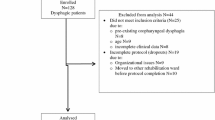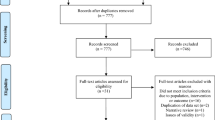Abstract
Dysphagia and its associated complications are expected to be relatively more frequent in stroke patients in Brazil than in similar patients treated in developed countries due to the suboptimal stroke care in many Brazilians medical services. However, there is no estimate of dysphagia and pneumonia incidence for the overall stroke population in Brazil. We conducted a systematic review of the recent literature to address this knowledge gap, first screening citations for relevance and then rating full articles of accepted citations. At both levels, judgements were made by two independent raters according to a priori criteria. Fourteen accepted articles underwent critical appraisal and data extraction. The frequency of dysphagia in stroke patients was high (59% to 76%). Few studies assessed pneumonia and only one study stratified patients by both dysphagia and pneumonia, with an increased Relative Risk for pneumonia in patients with stroke and dysphagia of 8.4 (95% CI 2.1, 34.4). Across all articles, we identified bias related to: heterogeneity in number and type of stroke; no rater blinding; and, assessments that were not reproducible, reliable or validated. Despite the high frequency of dysphagia and associated pneumonia in stroke patients in Brazil, the quality of the available literature is low and that there is little research focused on these epidemiologic data. Future rigorously designed studies are in dire need to accurately determine dysphagia incidence and its impact on stroke patients in Brazil. These data will be critical to properly allocate limited national resources that maximize the quality of stroke care.




Similar content being viewed by others
References
Minelli C, Fen LF, Minelli DPC. Stroke Incidence, Prognosis, 30-Day, and 1-Year Case Fatality Rates in Matão, Brazil A Population-Based Prospective Study. Stroke. 2007;38:2906–11.
Thrift AG, Thayabaranathan T, Howard G, et al. Global stroke statistics. Int J Stroke. 2017;12(1):13–32.
Lotufo PA. Stroke is still a neglected disease in Brazil. Sao Paulo Med J. 2015;133(6):457–9.
Pontes-Neto OM. Stroke awareness in Brazil: what information about stroke is essential? Arq Neuropsiquiatr. 2014;72(12):909–10.
de Carvalho JJ, Alves MB, Viana GA, et al. Stroke epidemiology, patterns of management, and outcomes in Fortaleza, Brazil: a hospital-based multicenter prospective study. Stroke. 2011;42(12):3341–6.
Pontes-Neto OM, Cougo-Pinto PT, Martins SC, et al. A new era of endovascular treatment for acute ischemic stroke: what are the implications for stroke care in Brazil? Arq Neuropsiquiatr. 2016;74(1):85–6.
Lotufo PA. Stroke in Brazil: a neglected disease. Sao Paulo Med J. 2005;123(1):3–4.
Copstein L, Fernandes JG, Bastos GA. Prevalence and risk factors for stroke in a population of Southern Brazil. Arq Neuropsiquiatr. 2013;71(5):294–300.
Martins SC, Pontes-Neto OM, Alves CV, et al. Past, present, and future of stroke in middle-income countries: the Brazilian experience. Int J Stroke. 2013;8(A100):106–11.
Pontes-Neto OM, Silva GS, Feitosa MR, et al. Stroke awareness in Brazil: alarming results in a community-based study. Stroke. 2008;39(2):292–6.
Leopoldino JF, Fukujima MM, Silva GS, et al. Time of presentation of stroke patients in São Paulo hospital. Arq Neuropsiquiatr. 2003;61(2A):186–7.
Martins SC, et al. Manual de rotinas para atenção ao AVC. Brasília: Editora do Ministério da Saúde; 2013.
Jauch EC, Saver JL, Adams HP, et al. Guidelines for the early management of patients with acute ischemic stroke: a guideline for healthcare professionals from the American Heart Association/American Stroke Association. Stroke. 2013;44(3):870–947.
Hebert D, Lindsay MP, McIntyre A, et al. Canadian stroke best practice recommendations: stroke rehabilitation practice guidelines, update 2015. Int J Stroke. 2016;11(4):459–84.
Rudd AG, Bowen A, Young G, et al. National clinical guideline for stroke. 5th ed. London: Royal College of Physicians; 2016.
Pontes-Neto OM, Cougo P, Martins SC, et al. Brazilian guidelines for endovascular treatment of patients with acute ischemic stroke. Arq Neuropsiquiatr. 2017;75(1):50–6.
Martino R, Foley NC, Bhogal SK, et al. Dysphagia after stroke: incidence, diagnosis, and pulmonary complications. Stroke. 2005;36(12):2756–63.
Paciaroni M, Mazzotta G, Corea F, et al. Dysphagia following Stroke. Eur Neurol. 2004;51(3):162–7.
Smithard DG, O’Neill PA, Parks C, et al. Complications and outcome after acute stroke. Does dysphagia matter? Stroke. 1996;27(7):1200–4.
Joundi RA, Martino R, Saposnik G, et al. Predictors and outcomes of dysphagia screening after acute ischemic stroke. Stroke. 2017;48(4):900–6.
Arnold M, Liesirov K, Broeg-Morvay A, et al. Dysphagia in acute stroke: incidence, burden and impact on clinical outcome. PLoS ONE. 2016;11(2):e0148424.
Al-Khaled M, Matthis C, Binder A, et al. Dysphagia in patients with acute ischemic stroke: early dysphagia screening may reduce stroke-related pneumonia and improve stroke outcomes. Cerebrovasc Dis. 2016;42:81–9.
Kishore AK, Vail A, Chamorro A, et al. How is pneumonia diagnosed in clinical stroke research? A systematic review and meta-analysis. Stroke. 2015;46(5):1202–9.
Eltringham SA, Kilner K, Gee M, et al. Impact of dysphagia assessment and management on risk of stroke-associated pneumonia: a systematic review. Cerebrovasc Dis. 2018;46:97–105.
Attrill S, White S, Murray J, et al. Impact of oropharyngeal dysphagia on healthcare cost and length of stay in hospital: a systematic review. BMC Health Serv Res. 2018;18:594.
Rofes L, Muriana D, Palomeras E, et al. Prevalence, risk factors and complications of oropharyngeal dysphagia in stroke patients: a cohort study. Neurogastroenterol Motil. 2018;23:e13338.
Schelp AO, Cola PC, Gatto AR, et al. Incidence of oropharyngeal dysphagia associated with stroke in a regional hospital in São Paulo State - Brazil. Arq Neuropsiquiatr. 2004;62(2B):503–6.
Higgins JP, Altman DG. Assessing risk of bias in included studies. In: Higgins JP, Green S, editors. Cochrane handbook for systematic reviews of interventions. Chichester: Wiley; 2008. p. 187–241.
Nunes MC, Jurkiewicz AL, Santos RS, et al. Correlation between brain injury and dysphagia in adult patients with stroke. Int Arch Otorhinolaryngol. 2012;16(3):313–21.
Mourão AM, Almeida EO, Lemos SM, et al. Evolution of swallowing in post-acute stroke: a descriptive study. Rev CEFAC. 2016;18(2):417–25.
Pinto G, Zétola V, Lange M, et al. Program to diagnose probability of aspiration pneumonia in patients with ischemic stroke. Int Arch Otorhinolaryngol. 2014;18(3):244–8.
Jacques A, Cardoso MC. Stroke followed by speech and language sequels: Hospital Procedures. Rev Neurocienc. 2011;19(2):229–36.
Otto DM, Ribeiro MC, Barea LM, et al. Association between neurological injury and the severity of oropharyngeal dysphagia after stroke. Codas. 2016;28(6):724–9.
Barros AF, Fábio SR, Furkim AM. Relation between clinical evaluation of deglutition and the computed tomography in acute ischemic stroke patients. Arq Neuropsiquiatr. 2006;64(4):1009–14.
Marques CH, Rosso AL, André C. Bedside assessment of swallowing in stroke: water tests are not enough. Top Stroke Rehabil. 2008;15(4):378–83.
Xerez DR, Carvalho YS, Costa MM. Clinical and videofluoroscopic study of dysphagia in patients with cerebrovascular accident in subacute phase. Radiol Bras. 2004;37(1):9–14.
Silva AC, Dantas RO, Fabio SR. Clinical and scintigraphic swallowing evaluation of post-stroke patients. Pro Fono. 2010;22(3):317–24.
Mituuti CT, Bianco VC, Bentim CG, et al. Influence of oral health condition on swallowing and oral intake level for patients affected by chronic stroke. Clin Interv Aging. 2015;10:29–35.
Diniz PB, Vanin G, Xavier R, et al. Reduced incidence of aspiration with spoon-thick consistency in stroke patients. Nutr Clin Pract. 2009;24(3):414–8.
Baroni AF, Fábio SR, Dantas RO. Risk factors for swallowing dysfunction in stroke patients. Arq Gastroenterol. 2012;49(2):118–24.
Okubo PC, Fábio SR, Domenis DR, et al. Using the National Institute of Health Stroke Scale to predict dysphagia in acute ischemic stroke. Cerebrovasc Dis. 2012;33(6):501–7.
Crary MA, Mann GD, Groher ME. Initial psychometric assessment of a functional oral intake scale for dysphagia in stroke patients. Arch Phys Med Rehabil. 2005;86(8):1516–20.
Macedo Filho ED. Avaliação Videoendoscópica da Deglutição (VED) na abordagem da disfagia orofaríngea. In: Jacobi JS, Levy DS, Silva LMC, editors. Disfagia Avaliação e Tratamento. Rio de Janeiro: Revinter; 2003. p. 332–42.
Smithard DG, Smeeton NC, Wolfe CD. Long-term outcome after stroke: does dysphagia matter? Age Ageing. 2007;36(1):90–4.
Mourão AM, Lemos SM, Almeida EO, et al. Frequency and factors associated with dysphagia in stroke. Codas. 2016;28(1):66–70.
McCullough GH, Rosenbek JC, Wertz RT, et al. Utility of clinical swallowing examination measures for detecting aspiration post-stroke. J Speech Lang Hear Res. 2005;48(6):1280–93.
McCullough GH, Wertz RT, Rosenbek JC. Sensitivity and specificity of clinical/bedside examination signs for detecting aspiration in adults subsequent to stroke. J Commun Disord. 2001;34(1–2):55–72.
Donovan NJ, Daniels SK, Edmiaston J, et al. Dysphagia screening: state of the art: invitational conference proceeding from the State-of-the-Art Nursing Symposium, International Stroke Conference 2012. Stroke. 2013;44(4):e24–31.
Ostrofsky C, Seedat J. The South African dysphagia screening tool (SADS): a screening tool for a developing context. S Afr J Commun Disord. 2016;63(1):117.
Sundar U, Pahuja V, Dwivedi N, et al. Dysphagia in acute stroke: correlation with stroke subtype, vascular territory and in-hospital respiratory morbidity and mortality. Neurol India. 2008;56(4):463–70.
Hoffmeister L, Lavados PM, Comas M, et al. Performance measures for in-hospital care of acute ischemic stroke in public hospitals in Chile. BMC Neurol. 2013;13:23.
Rosenbek JC, Robbins JA, Roecker EB, et al. A penetration-aspiration scale. Dysphagia. 1996;11(2):93–8.
Trapl M, Enderle P, Nowotny M, et al. Dysphagia bedside screening for acute-stroke patients: the gugging swallowing screen. Stroke. 2007;38(11):2948–52.
Ellul J, Barer D, Fall S. Improving detection and management of swallowing problems in acute stroke: a multi-centre study. Cerebrovasc Dis. 1997;7:18.
Silva RG. Disfagia neurogênica em adultos pós-acidente vascular encefálico: identificação e classificação. Dissertation. São Paulo: Universidade Federal de São Paulo; 1997.
O’Neil-Pirozzi TM, Lisiecki DJ, Jack Momose K, et al. Simultaneous modified barium swallow and blue dye tests: a determination of the accuracy of blue dye test aspiration findings. Dysphagia. 2003;18(1):32–8.
Silva RG, Gatto AR, Cola PC. Disfagia orofaríngea neurogênica em adultos - avaliação fonoaudiológica em leito hospitalar. In: Jacobi JS, Levy DS, Silva LMC, editors. Disfagia avaliação e tratamento. Rio de Janeiro: Revinter; 2003. p. 181–93.
Acknowledgements
The authors would like to thank National Council of Scientific and Technological Development of Brazil (CNPq) and Coordination of Improvement of Higher Level Personnel (CAPES). Support from National Council of Scientific and Technological Development of Brazil (CNPq – 482721/2013-8 and 402388/2013-5) and Coordination of Improvement of Higher Level Personnel (CAPES).
Author information
Authors and Affiliations
Contributions
The authors participated sufficiently in the work to take public responsibility for appropriate portions of the content.
Corresponding author
Ethics declarations
Conflict of interest
The authors declared no potential conflicts of interest with respect of the research, authorship, and publication of this article.
Research Ethics Committee and Informed Consent
All studies included in this systematic review involving human subjects declared that they were performed after approval by the appropriate Research Ethics Committee and that the written informed consent was obtained from all participants.
Additional information
Publisher's Note
Springer Nature remains neutral with regard to jurisdictional claims in published maps and institutional affiliations.
Appendix
Rights and permissions
About this article
Cite this article
Pacheco-Castilho, A.C., Vanin, G.M., Dantas, R.O. et al. Dysphagia and Associated Pneumonia in Stroke Patients from Brazil: A Systematic Review. Dysphagia 34, 499–520 (2019). https://doi.org/10.1007/s00455-019-10021-0
Received:
Revised:
Accepted:
Published:
Issue Date:
DOI: https://doi.org/10.1007/s00455-019-10021-0




